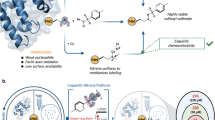Abstract
Colonic tumour cells possess a cell surface protease capable of binding 9-aminoacridine to its active centre, thus locating cells when viewed under a fluorescence microscope. In vivo and in frozen sections, the enzyme is masked by a protein inhibitor. This inhibitor can be displaced by formaldehyde fixation of the tissue and then replaced by adding a fresh extract of colon or lung tissue. The inhibitor is modified by oxidation; provided by air, oxidized glutathione or potassium permanganate, resulting in a change in conformation in the inhibitor and this then results in the enzyme binding the fluorescent probe. The effect of oxidation can be reversed by dithiothreitol. It is proposed that these changes are brought about by a disulphide exchange acting on the inhibitor which indirectly controls the activity of the cell surface enzyme in vivo. The steps described above can be conveniently followed on sections of tissue mounted on a microscope slide; this has the advantage that the same cells can be monitored during a sequence of reactions. It is believed that these techniques could well be applied to other enzyme systems than the tumour protease described in this study.
Similar content being viewed by others
Author information
Authors and Affiliations
Rights and permissions
About this article
Cite this article
Steven, F., Ali, H. & Griffin, M. The inhibition of a tumour cell surface protease in vivo and its re-activation by oxidation. Br J Cancer 57, 160–164 (1988). https://doi.org/10.1038/bjc.1988.33
Issue Date:
DOI: https://doi.org/10.1038/bjc.1988.33
- Springer Nature Limited
This article is cited by
-
The status of trypsin-like enzymes in squamous-cell carcinoma of the head and neck region
Journal of Cancer Research and Clinical Oncology (1990)




